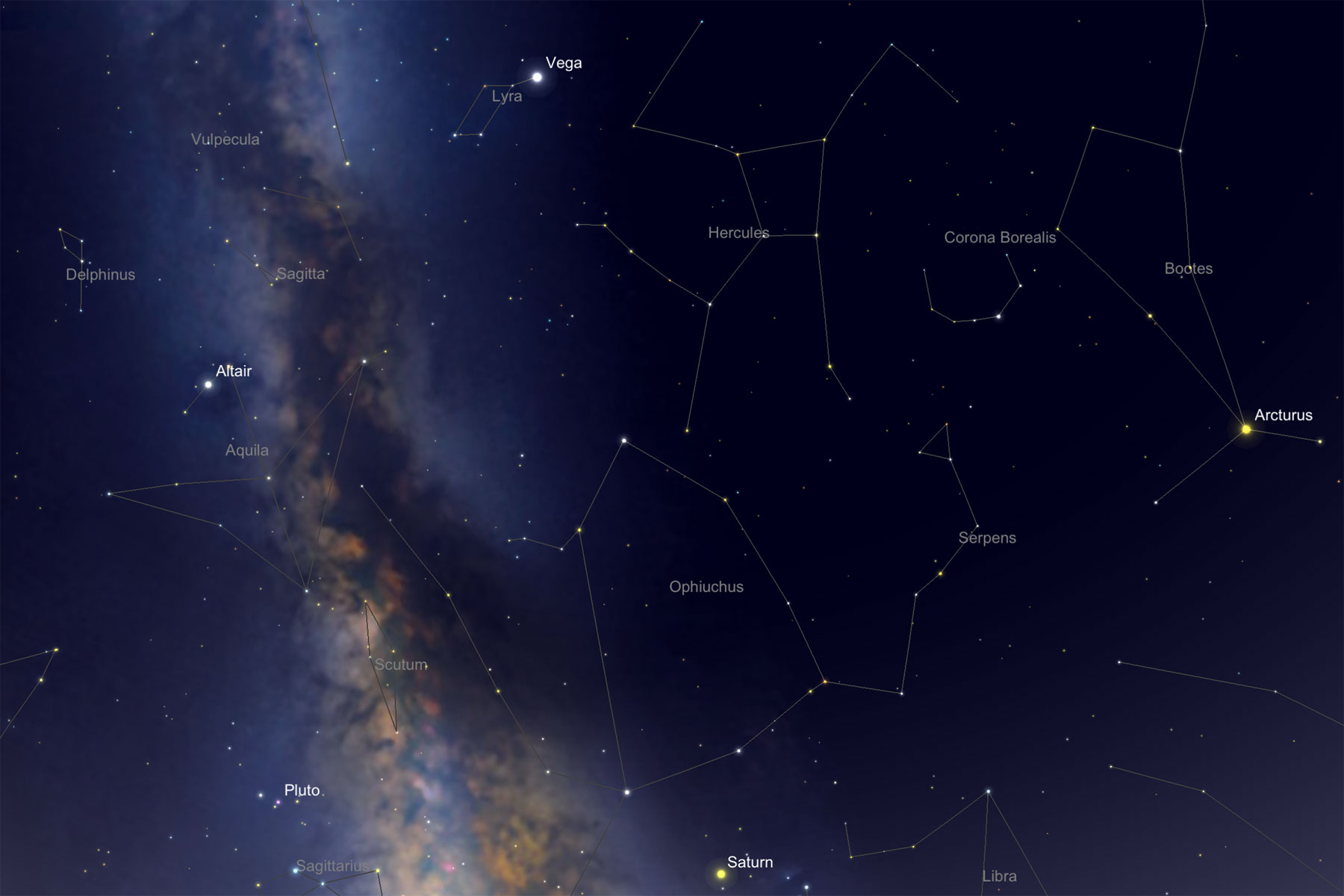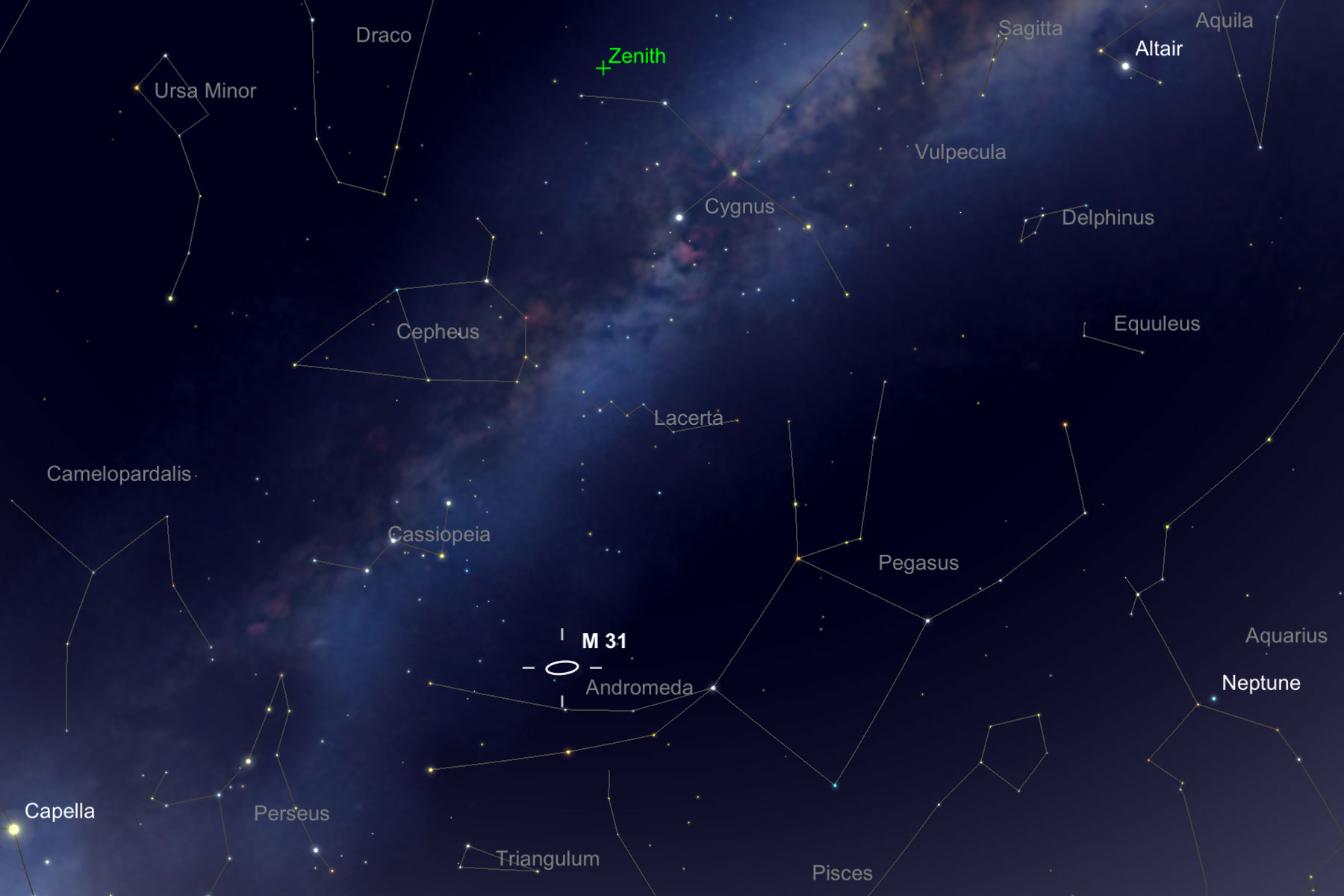Deep Sky Summer/Autumn Observations August/October 2016
Conditions | Observation Overview | List of Observed Sky Objects | References
From August to October 2016, I conducted simple "deep-sky summer / autumn observations," which might be of interest to other beginners and are therefore described here. Please note that this page primarily serves as a preparation for the respective observations in summer and fall 2017.
Note: This is more a "preparation page" for observations that I hope to conduct in 2017. I list here already the most important deep sky objects that I would like to observe during the next year and that I already tried to observe, but for different reasons was not able to find in part.
Conditions
Sky Region and Objects
I first confined my observations to the sky area in the south with Hercules, Ophiuchus, Cygnus, Lyra.... Later, I extended my observations to the area between Andromeda, Cassiopeia, and Perseus, as well as Pegasus.
Overview Map
The following map shows approximately the sky area that I primarily browsed during my observations:
Click the map for a larger version - it opens in a new window (Image Courtesy of SkySafari Astronomy, www.simulationcurriculum.com)
And here is the section of the sky in the East with Cassiopeia, Perseus, Andromeda, Pegasus a.s.o. that I observed mostly in France:
Click the map for a larger version - it opens in a new window (Image Courtesy of SkySafari Astronomy, www.simulationcurriculum.com)
Observation Time
My observations started in August and ended in early October (apart from one exception); I began observing some time after dusk (which is late in summer, often only after 9 pm) and before midnight.
Observation Location
Most observations were conducted in Mühlhausen/Kraichgau (Germany):
- Coordinates: 49° 15′ N , 8° 43′ E
- Coordinates (dec.): 49,25° N, 8,72° E
I conducted further deep sky observations in Erkerode (near Braunschweig, Germany) and later in autumn also in France (Sumène, Haute Loire, France).
Devices Used
I tried all my telescopes (that I owned at that time) and, as far as possible, also used them on the Sky-Watcher Star Discovery AZ GoTo mount:
- Sky-Watcher Heritage P130
- Sky-Watcher Heritage 100P
- GSO GSD 680
- Sky-Watcher Skymax-102 OTA
- Leica Trinovid 10 x 25 binoculars
That was in the making, however, so I did not use the GoTo control often. Moreover, I used my 10 x 25 Leica binoculars, which are not all night glasses. I used all kinds of eyepieces, but preferred my UWA eyepieces (16 mm, 7 mm, 4 mm), as well as a 32 mm Plössl eyepiece for maximum overview.
General Conditions
In general, the sky above Mühlhausen/Kraichgau is "light-polluted" and does not invite you to search for Deep Sky objects. This is certainly one of the reasons why I found some of the Deep Sky objects that I wanted to observe only sometimes or not at all. Often, the sky was not yet dark enough for observing deep sky objects ...
I conducted further deep sky observations in Erkerode (near Braunschweig, Germany) and later in autumn also in France (Sumène, Haute Loire, France).
Observation Overview
| Date 2016 |
Observed Objects | Details, Remarks | Further Observations and Remarks | Devices Used | Eyepieces Used |
| End of August | GE: M 8 (NGC 6523; Lagoon nebula), M 20 (Trifid nebula) | Erkerode | Heritage 100P | various magnifications | |
| End of August | GC: M 13 (Hercules cluster), M 92 | Mühlhausen/Kraichgau (MH) | Heritage 100P, Heritage P130, GSD 680 | various magnifications | |
| Sep 1 | GC: M 13, M 92 | MH | Heritage 100P, Heritage P130, GSD 680; Heritage 100P and Heritage P130 also on GoTo mount | various magnifications | |
| Sep 3 | G: M 31 (Andromeda Galaxy) | MH | Heritage 100P | ? | |
| Sep 6 | G: M 31 GC: M 92 |
MH | Heritage 100P on GoTo mount, Heritage P130 on GoTo mount | ? | |
| Sep 7 | PN: M 57 (Ring nebula) OC: IC 4665, M 16 (NGC 6611) + IC 4703 (Eagle nebula), M 17 + NGC 6618 (Omega nebula, Swan nebula), M 11 (NGC 6705; Wild Ducks cluster) GC: M 13, M 92, M 10, M 12 |
MH | M 5 not found (low, behind tree) Eagle and Omega nebulae not found |
Skymax 102 on GoTo mount | ? |
| Sep 9 | PN: M 57 G: M 31 OC: M 11 (NGC 6705) GC: M 13, M 92 |
MH | NGC 6633 too low, not found M 5 not found (low, behind tree) |
Heritage P130 on GoTo mount | ? |
| End of Sept/Beg. of Okt | G: M 31 OC: NGC 884/NGC 869 (Perseus double cluster), M 103, NGC 663, NGC 654 GC: M 13, M 15 |
France (Sumène), M 13 also in binoculars | M 57, M 56 not found | Heritage 100P, binoculars | various magnifications |
| Oct 31 | OC: M 45 (Pleiades) GC: M 13, M 15 |
MH, M 13: faint in bino, M 15 with 100P, not with binoculars | Heritage 100P, binoculars | 16 mm, 7mm, 4mm UWA |
Bold: First observation during this observation period; all observations in Mühlhausen/Kraichgau; GE = galactic emission nebula, GR = galactic reflection nebula, PN = planetary nebula, G = galaxy, OC = open star cluster, GC = globular star cluster
List of Observed Sky Objects
Object details can be obtained via the links to the relevant deep sky objects.
| DSO
Details |
Name | Constellation | Type | Bino* | 100P | 100P GT |
SM102 GT |
P130 GT |
GSD 680 | Remarks |
| M 13 | Hercules Nebula | Hercules | GC | yes | yes | yes | yes | yes | yes | prime object |
| M 92 | Hercules | GC | yes | yes | yes | yes | yes | yes | harder to find than M 13 | |
| M 29 | Cygnus | OC | ||||||||
| NGC 6960/6992/5 | Cirrus/Veil Nebula | Cygnus | PN | |||||||
| NGC 7000 | North America Nebula | Cygnus | GE | |||||||
| M 27 | Dumbbell Nebula | Vulpecula | PN | glow, but no dumbbell seen (nothing documented apart from this) | ||||||
| Cr 399 | Coat Hanger | Vulpecula | SP | not found | ||||||
| M 57 | Ring Nebula | Lyra | PN | no | yes | yes | a hint of the ring at best | |||
| M 56 | Lyra | GC | a small sphere | |||||||
| M 71 | Sagitta | GC | very loose | |||||||
| M 10 | Ophiuchus | GC | yes | a faint glow | ||||||
| M 12 | Ophiuchus | GC | yes | a faint glow | ||||||
| IC 4665 | Ophiuchus | OC | yes | only relatively distant stars | ||||||
| NGC 6633 | Ophiuchus | OC | already too low on the horizon | |||||||
| M 5 | Serpens Caput | GC | already too low on the horizon | |||||||
| IC 4756 | Serpens Cauda | OC | probably not found | |||||||
| M 16/IC 4703 | Eagle Nebula | Serpens Cauda | OC/GE | yes | appeared as a very wide open star cluster; did not see the nebula IC 4703 | |||||
| M 17 | Omega/Swan Nebula | Sagittarius | GE | yes | saw only stars and, at best, a faint glow | |||||
| M 8/NGC 6530 | Lagoon Nebula | Sagittarius | OC/GE | yes | yes | saw only stars, maybe some faint glow in the Lagoon Nebula | ||||
| M 20 | Trifid Nebula | Sagittarius | GE | ? | ? | ? | not found | |||
| M 11 | Wild Duck Cluster | Scutum | GC | yes | yes | saw stars and some nebula around them | ||||
| M 31 | Andromeda Galaxy | Andromeda | G | yes? | yes | yes | yes | in the North-East; a glow, no details | ||
| NGC 884/869 | Double Star Cluster | Perseus | OC | yes | in the North-East | |||||
| M 15 | Pegasus | GC | yes | |||||||
| M 103 | Cassiopeia | OC | yes | looked more like a small asterism | ||||||
| NGC 663 | Cassiopeia | OC | yes | |||||||
| NGC 654 | Cassiopeia | OC | not found | |||||||
| NGC 457 | Owl Cluster, ET Cluster | Cassiopeia | OC | probably not observed | ||||||
| St 2 | Muscle Man | Cassiopeia | OC | not observed |
*) 10 x 25 binoculars; GE = galactic emission nebula, GR = galactic reflection nebula, G = galaxy, OC = open star cluster, GC = globular star cluster, DS = double star, SP = star pattern, SC = star cloud
References
Books
- Michael Feiler & Philip Novak (2023). Deep Sky Reiseatlas (5. Auflage), Oculum Verlag (ISBN 978-3-949370-04-5)
www.oculum-verlag.de/detailview?no=608 - Ronald Stoyan (2021). Deep Sky Reiseführer (6. Auflage), Oculum Verlag (ISBN 978-3-938469-72-9)
www.oculum-verlag.de/detailview?no=603 - Erich Karkoschka (2022). Atlas für Himmelsbeobachter, Kosmos Verlag (EAN: 9783440173602)
www.kosmos.de/de/atlas-fur-himmelsbeobachter_1074889_9783440173602
On this Website
- Overview of Observations
- DSO List (Collected from Books)
- Sky-Watcher Heritage P130 Information (5" Dobson)
- Sky-Watcher Heritage 100P Information (4" Dobson)
- GSO GSD 680 Information (8" Dobson)
- Sky-Watcher Skymax-102 OTA Information (4" Maksutov-Cassegrain)
- Sky-Watcher Star Discovery AZ GoTo Mount Information
- My Binoculars
| 28.04.2024 |

